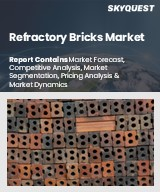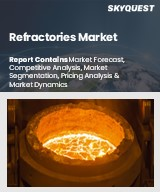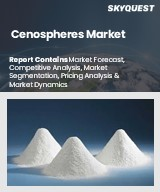
|
시장보고서
상품코드
1833560
세계의 내화물 재료 시장 예측 : 형상, 재료, 알칼리도, 제조 공정, 최종 사용자, 지역별 분석(-2032년)Refractories Materials Market Forecasts to 2032 - Global Analysis By Form (Shaped Refractories and Unshaped Refractories), Material, Alkalinity, Manufacturing Process, End User and By Geography |
||||||
Stratistics MRC에 따르면 세계 내화물 재료 시장은 2025년 503억 달러, 예측 기간 동안 CAGR 11%로 성장하고, 2032년에는 1,045억 달러에 이를 전망입니다.
내화물은 매우 높은 온도, 화학 부식, 기계적 스트레스를 견딜 수 있도록 설계된 특수 물질이며 철강, 시멘트, 유리, 세라믹 제조와 같은 산업 응용 분야에 필수적입니다. 이 재료는 퍼니스, 킬른, 반응로 및 기타 고열 환경에서 구조적 무결성과 열적 안정성을 유지합니다. 내화물은 정형(벽돌) 또는 비정형(부정형)으로 분류되며, 알루미나, 실리카, 마그네시아 등의 점토 또는 비점토 기재의 재료로 구성됩니다. 그 내구성, 단열성, 슬래그나 열충격에 대한 내성에 의해 효율적이고 안전한 고온 조업에 빠뜨릴 수 없는 것이 되고 있습니다.
도시화와 인프라 개발
철강, 시멘트 및 유리 생산의 확대는 고성능 단열 솔루션의 대량 소비에 박차를 가하고 있습니다. 첨단 제조업과 에너지 효율적인 공정과의 통합은 세계 공급망 전반에 걸친 채택을 촉진하고 있습니다. 산업 회랑이나 스마트 시티에의 공공 및 민간 투자가 시장 확대를 뒷받침하고 있습니다. 퍼니스 설계 및 열 봉쇄의 기술적 업그레이드가 제품 혁신을 뒷받침합니다. 이러한 역학이 내화물 재료 시장을 크게 활성화할 것으로 예상됩니다.
원재료 변동과 고비용
마그네시아, 알루미나, 흑연의 조달량의 변동은 공급망을 혼란시켜 조달 위험을 높입니다. 수입 의존과 지정학적 혼란은 중요한 원료에 대한 접근을 제한합니다. 제조업체는 성능 기준을 충족하면서 비용 경쟁력을 유지하는 문제에 직면하고 있습니다. 채굴과 추출에 대한 규제 압력은 주요 지역에서의 입수를 제한합니다. 이러한 제약이 내화물 재료 시장을 제약할 것으로 예측됩니다.
신흥 경제국의 미개척 성장 시장
남아시아, 아프리카, 라틴아메리카의 산업화는 에너지 및 제조업 내열성 부품에 대한 새로운 수요를 발굴하고 있습니다. 인프라의 업그레이드와 에너지 다양화에 대한 노력이 새로운 분야에서의 채택을 촉진하고 있습니다. 현지 생산 장려책과 무역자유화가 지역공급망 개발을 추진하고 있습니다. 맞춤형 저비용 내화물 솔루션에 대한 수요는 모듈형 기술 혁신을 뒷받침하고 있습니다. 이러한 추세는 내화물 재료를 크게 활성화할 것으로 예상됩니다.
환경과 규제의 과제
배출규제의 의무화와 지속가능성 컴플라이언스 요건은 비용압력을 강화하고 생산주기를 늦추고 있습니다. 인증 지연과 표준 진화는 중소기업 시장 진입을 제한하고 있습니다. 환경 친화적인 배합을 채택하도록 요구하는 압력이 기존의 제품 라인을 저해하고 있습니다. 제조업체 각 사는 순환형 경제의 틀과 그린 건설 규범과의 무결성에 있어서 장벽에 직면하고 있습니다. 이러한 제약이 내화물 재료 시장의 방해가 될 것으로 예측됩니다.
COVID-19의 영향 :
COVID-19의 유행은 세계 공급망을 혼란시키고 산업 프로젝트를 지연시키고 내화물 재료 수요에 영향을 미쳤습니다. 철강과 시멘트 생산의 가동 중단은 전체 핵심 부문의 소비를 일시적으로 감소시켰습니다. 물류의 병목과 노동력 부족이 제조와 유통을 제약했습니다. 팬데믹 이후의 회복은 새로운 인프라 지출과 산업 재가동으로 가속화되고 있습니다. 디지털 조달 모델과 현지화된 조달 전략은 공급망의 탄력성을 촉진합니다. 이러한 변화는 내화물 재료 시장을 촉진할 것으로 예측됩니다.
예측 기간 동안 정형 내화물 부문이 최대가 될 전망
예측 기간 동안 정밀 가공된 열 부품 수요를 견인하는 정형 내화물 분야가 최대 시장 점유율을 차지할 것으로 예측됩니다. 벽돌, 블록, 예비 성형된 형상이 고온 산업용도에서의 채택을 가속하고 있습니다. 철강, 시멘트 및 유리의 각 분야에서 구조적 무결성과 열효율을 위해 성형 부품의 사용이 확대되고 있습니다. 자동 설치 시스템과의 통합으로 작업 속도와 일관성이 향상되었습니다. 제조업체 각 회사는 진화하는 성능 기준을 충족하기 위해 내구성과 내식성이 우수한 설계에 투자하고 있습니다. 이 부문은 내화물 재료 시장을 촉진할 것으로 예상됩니다.
비철금속 부문은 예측기간 중 가장 높은 CAGR이 예상된다.
예측 기간 동안 비철금속 부문이 가장 높은 성장률을 보이고 특수 내화물 솔루션에 대한 수요를 견인할 것으로 예측됩니다. 구리, 알루미늄, 아연 가공 시설에서는 고성능 라이닝과 단열재의 사용이 가속화되고 있습니다. 열충격 내성과 화학적 안정성이 복잡한 제련 환경에서의 채택을 촉진하고 있습니다. 에너지 효율적인 용광로 및 재활용 시스템과의 통합이 혁신을 촉진하고 있습니다. 비철 야금에 대한 지역 투자가 시장 침투를 뒷받침하고 있습니다.
최대 점유율을 차지하는 지역 :
예측 기간 동안 아시아태평양이 가장 큰 시장 점유율을 차지할 것으로 예측됩니다. 중국, 인도, 일본, 한국은 철강, 시멘트, 유리의 생산을 가속화하고 있으며 내화물의 중심 소비국이 되고 있습니다. 정부의 지원으로 인프라 계획과 에너지 프로젝트가 수요를 촉진하고 있습니다. 현지 제조 능력과 경쟁력 있는 가격 설정이 이 지역의 우위를 높이고 있습니다. 전략적 파트너십과 기술 이전이 제품 포트폴리오를 확대하고 있습니다.
CAGR이 가장 높은 지역 :
예측 기간 동안 중동 및 아프리카은 인프라 정비 및 산업 다양화로 인해 가장 높은 CAGR을 나타낼 것으로 예측됩니다. 비철 야금, 석유화학, 에너지 프로젝트에 대한 투자가 높은 내화물 솔루션에 대한 수요를 가속화하고 있습니다. 지역정부는 산업지대와 무역우대 조치를 통해 제조업의 성장을 가속하고 있습니다. 지속 가능한 건설 방법의 채택은 환경 친화적인 내화물 형식에 대한 관심을 높입니다. 신흥 시장에서는 기존 에너지와 재생가능에너지 분야에서의 사용이 확대되고 있습니다.
무료 주문을 받아서 만드는 서비스 :
이 보고서를 구독하는 고객은 다음 무료 맞춤설정 옵션 중 하나를 사용할 수 있습니다.
- 기업 프로파일
- 추가 시장 기업의 종합적 프로파일링(3개사까지)
- 주요 기업의 SWOT 분석(3개사까지)
- 지역 세분화
- 고객의 관심에 응한 주요국 시장 추정, 예측 및 CAGR(주 : 타당성 확인에 따름)
- 경쟁 벤치마킹
- 제품 포트폴리오, 지리적 존재, 전략적 제휴에 기반한 주요 기업 벤치마킹
목차
제1장 주요 요약
제2장 서문
- 개요
- 이해관계자
- 조사 범위
- 조사 방법
- 데이터 마이닝
- 데이터 분석
- 데이터 검증
- 조사 접근
- 조사 자료
- 1차 조사 자료
- 2차 조사 정보원
- 전제조건
제3장 시장 동향 분석
- 성장 촉진요인
- 억제요인
- 기회
- 위협
- 최종 사용자 분석
- 신흥 시장
- COVID-19의 영향
제4장 Porter's Five Forces 분석
- 공급기업의 협상력
- 구매자의 협상력
- 대체품의 위협
- 신규 참가업체의 위협
- 경쟁 기업간 경쟁 관계
제5장 세계의 내화물 재료 시장 : 형상별
- 정형 내화물
- 부정형 내화물
제6장 세계의 내화물 재료 시장 : 재료별
- 점토질 내화물
- 내화 점토
- 고알루미나
- 비점토계 내화물
- 마그네사이트
- 백운석
- 실리카
- 크롬 철광
- 지르코니아
- 탄소
제7장 세계의 내화물 재료 시장 : 알칼리도별
- 산성 내화물
- 염기성 내화물
- 중성 내화물
제8장 세계의 내화물 재료 시장 : 제조 공정별
- 드라이 프레스 프로세스
- 용융 주조
- 수작업 성형
- 형성
- 미형성
제9장 세계 내화물 재료 시장 : 최종 사용자별
- 철강
- 시멘트
- 유리
- 비철금속
- 발전
- 석유화학제품과 화학제품
- 기타 최종 사용자
제10장 세계의 내화물 재료 시장 : 지역별
- 북미
- 미국
- 캐나다
- 멕시코
- 유럽
- 독일
- 영국
- 이탈리아
- 프랑스
- 스페인
- 기타 유럽
- 아시아태평양
- 일본
- 중국
- 인도
- 호주
- 뉴질랜드
- 한국
- 기타 아시아태평양
- 남미
- 아르헨티나
- 브라질
- 칠레
- 기타 남미
- 중동 및 아프리카
- 사우디아라비아
- 아랍에미리트(UAE)
- 카타르
- 남아프리카
- 기타 중동 및 아프리카
제11장 주요 발전
- 계약, 파트너십, 협업, 합작투자
- 인수와 합병
- 신제품 발매
- 사업 확대
- 기타 주요 전략
제12장 기업 프로파일링
- Saint-Gobain
- Imerys
- RHI Magnesita
- POSCO Future M Co., Ltd.
- KAEFER SE & Co. KG
- Beijing Lier High-Temperature Materials Co., Ltd.
- HarbisonWalker International
- Intocast Group
- Alsey Refractories Co.
- Magnezit Group
- Chosun Refractories Co., Ltd.
- CoorsTek Inc.
- Krosaki Harima Corporation
- Morgan Advanced Materials
According to Stratistics MRC, the Global Refractories Materials Market is accounted for $50.3 billion in 2025 and is expected to reach $104.5 billion by 2032 growing at a CAGR of 11% during the forecast period. Refractory materials are specialized substances designed to withstand extremely high temperatures, chemical corrosion, and mechanical stress, making them essential for industrial applications such as steel, cement, glass, and ceramics production. These materials maintain structural integrity and thermal stability in furnaces, kilns, reactors, and other high-heat environments. Refractories can be classified as shaped (bricks) or unshaped (monolithic) and are composed of clay-based or non-clay-based materials like alumina, silica, and magnesia. Their durability, thermal insulation, and resistance to slag and thermal shock make them critical for efficient and safe high-temperature operations.
Market Dynamics:
Driver:
Urbanization & infrastructure development
Expansion of steel, cement, and glass production is fueling large-scale consumption of high-performance thermal insulation solutions. Integration with advanced manufacturing and energy-efficient processes is fostering adoption across global supply chains. Public and private investments in industrial corridors and smart cities are propelling market expansion. Technological upgrades in furnace design and heat containment are boosting product innovation. These dynamics are expected to significantly boost the refractories materials market.
Restraint:
Volatility & high cost of raw materials
Fluctuations in magnesia, alumina, and graphite sourcing continue to disrupt supply chains and elevate procurement risks. Import dependence and geopolitical disruptions are constraining access to critical inputs. Manufacturers face challenges in maintaining cost competitiveness while meeting performance standards. Regulatory pressure on mining and extraction is limiting availability across key regions. These limitations are expected to constrain the refractories materials market.
Opportunity:
Untapped and growing markets in emerging economies
Industrialization across South Asia, Africa, and Latin America is unlocking new demand for heat-resistant components in energy and manufacturing. Infrastructure upgrades and energy diversification initiatives are fostering adoption across new verticals. Local manufacturing incentives and trade liberalization are propelling regional supply chain development. Demand for customized, low-cost refractory solutions is boosting innovation in modular formats. These trends are expected to significantly boost the refractories materials market.
Threat:
Environmental & regulatory challenges
Emission control mandates and sustainability compliance requirements are intensifying cost pressures and slowing production cycles. Certification delays and evolving standards are constraining market entry for smaller players. Pressure to adopt eco-friendly formulations is hindering legacy product lines. Manufacturers face barriers in aligning with circular economy frameworks and green construction norms. Such constraints are expected to hinder the refractories materials market.
Covid-19 Impact:
The Covid-19 pandemic disrupted global supply chains and delayed industrial projects, impacting refractory material demand. Shutdowns in steel and cement production temporarily degraded consumption across core sectors. Logistics bottlenecks and workforce shortages constrained manufacturing and distribution. Post-pandemic recovery is accelerating due to renewed infrastructure spending and industrial restarts. Digital procurement models and localized sourcing strategies are fostering resilience in supply chains. These shifts are expected to propel the refractories materials market.
The shaped refractories segment is expected to be the largest during the forecast period
The shaped refractories segment is expected to account for the largest market share during the forecast period driving demand for precision-engineered thermal components. Bricks, blocks, and preformed shapes are accelerating adoption in high-temperature industrial applications. Steel, cement, and glass sectors are expanding use of shaped formats for structural integrity and thermal efficiency. Integration with automated installation systems is fostering operational speed and consistency. Manufacturers are investing in durable, corrosion-resistant designs to meet evolving performance standards. This segment is expected to significantly boost the refractories materials market.
The non-ferrous metals segment is expected to have the highest CAGR during the forecast period
Over the forecast period, the non-ferrous metals segment is predicted to witness the highest growth rate drive demand for specialized refractory solutions. Copper, aluminum, and zinc processing facilities are accelerating use of high-performance linings and insulation. Thermal shock resistance and chemical stability are fostering adoption in complex smelting environments. Integration with energy-efficient furnaces and recycling systems is propelling innovation. Regional investments in non-ferrous metallurgy are boosting market penetration.
Region with largest share:
During the forecast period, the Asia Pacific region is expected to hold the largest market share driven by rapid urbanization and industrial expansion across key economies. China, India, Japan, and South Korea are accelerating production of steel, cement, and glass-core consumers of refractory materials. Government-backed infrastructure programs and energy projects are fostering demand. Local manufacturing capacity and competitive pricing are boosting regional dominance. Strategic partnerships and technology transfers are expanding product portfolios.
Region with highest CAGR:
Over the forecast period, the Middle East & Africa region is anticipated to exhibit the highest CAGR by infrastructure development and industrial diversification. Investments in non-ferrous metallurgy, petrochemicals, and energy projects are accelerating demand for advanced refractory solutions. Regional governments are fostering manufacturing growth through industrial zones and trade incentives. Adoption of sustainable construction practices is boosting interest in eco-friendly refractory formats. Emerging markets are expanding use in both traditional and renewable energy sectors.
Key players in the market
Some of the key players in Refractories Materials Market include Saint-Gobain, Imerys, RHI Magnesita, POSCO Future M Co., Ltd., KAEFER SE & Co. KG, Beijing Lier High-Temperature Materials Co., Ltd., HarbisonWalker International, Intocast Group, Alsey Refractories Co., Magnezit Group, Chosun Refractories Co., Ltd., CoorsTek Inc., Krosaki Harima Corporation and Morgan Advanced Materials.
Key Developments:
In June 2025, RHI Magnesita and BPI, Inc. announced a strategic joint venture to accelerate circular economy initiatives in North America. This collaboration combines RHI Magnesita's global refractory expertise with BPI's robust U.S. infrastructure, local sourcing, and technical processing capabilities.
In August 2025, Saint-Gobain Performance Ceramics & Refractories acquired Ceramco, a privately owned company specializing in industrial ceramics. This acquisition enhances Saint-Gobain's capabilities in the ceramic market for non-ferrous industries, allowing for a more comprehensive product offering and expanded research and development initiatives.
In May 2022, Imerys and Saint-Gobain announced a partnership to develop next-generation refractory materials, including dry ramming mass, for the steelmaking industry. This collaboration aims to leverage the expertise of both companies to create innovative and sustainable refractory solutions.
Forms Covered:
- Shaped Refractories
- Unshaped Refractories
Materials Covered:
- Clay-Based Refractories
- Non-Clay-Based Refractories
- Magnesite
- Dolomite
- Silica
- Chromite
- Zirconia
- Carbon
Alkalinities Covered:
- Acidic Refractories
- Basic Refractories
- Neutral Refractories
Manufacturing Processes Covered:
- Dry Press Process
- Fused Cast
- Hand Molded
- Formed
- Unformed
End Users Covered:
- Iron & Steel
- Cement
- Glass
- Non-Ferrous Metals
- Power Generation
- Petrochemicals & Chemicals
- Other End Users
Regions Covered:
- North America
- US
- Canada
- Mexico
- Europe
- Germany
- UK
- Italy
- France
- Spain
- Rest of Europe
- Asia Pacific
- Japan
- China
- India
- Australia
- New Zealand
- South Korea
- Rest of Asia Pacific
- South America
- Argentina
- Brazil
- Chile
- Rest of South America
- Middle East & Africa
- Saudi Arabia
- UAE
- Qatar
- South Africa
- Rest of Middle East & Africa
What our report offers:
- Market share assessments for the regional and country-level segments
- Strategic recommendations for the new entrants
- Covers Market data for the years 2024, 2025, 2026, 2028, and 2032
- Market Trends (Drivers, Constraints, Opportunities, Threats, Challenges, Investment Opportunities, and recommendations)
- Strategic recommendations in key business segments based on the market estimations
- Competitive landscaping mapping the key common trends
- Company profiling with detailed strategies, financials, and recent developments
- Supply chain trends mapping the latest technological advancements
Free Customization Offerings:
All the customers of this report will be entitled to receive one of the following free customization options:
- Company Profiling
- Comprehensive profiling of additional market players (up to 3)
- SWOT Analysis of key players (up to 3)
- Regional Segmentation
- Market estimations, Forecasts and CAGR of any prominent country as per the client's interest (Note: Depends on feasibility check)
- Competitive Benchmarking
- Benchmarking of key players based on product portfolio, geographical presence, and strategic alliances
Table of Contents
1 Executive Summary
2 Preface
- 2.1 Abstract
- 2.2 Stake Holders
- 2.3 Research Scope
- 2.4 Research Methodology
- 2.4.1 Data Mining
- 2.4.2 Data Analysis
- 2.4.3 Data Validation
- 2.4.4 Research Approach
- 2.5 Research Sources
- 2.5.1 Primary Research Sources
- 2.5.2 Secondary Research Sources
- 2.5.3 Assumptions
3 Market Trend Analysis
- 3.1 Introduction
- 3.2 Drivers
- 3.3 Restraints
- 3.4 Opportunities
- 3.5 Threats
- 3.6 End User Analysis
- 3.7 Emerging Markets
- 3.8 Impact of Covid-19
4 Porters Five Force Analysis
- 4.1 Bargaining power of suppliers
- 4.2 Bargaining power of buyers
- 4.3 Threat of substitutes
- 4.4 Threat of new entrants
- 4.5 Competitive rivalry
5 Global Refractories Materials Market, By Form
- 5.1 Introduction
- 5.2 Shaped Refractories
- 5.3 Unshaped Refractories
6 Global Refractories Materials Market, By Material
- 6.1 Introduction
- 6.2 Clay-Based Refractories
- 6.2.1 Fireclay
- 6.2.2 High Alumina
- 6.3 Non-Clay-Based Refractories
- 6.4 Magnesite
- 6.5 Dolomite
- 6.6 Silica
- 6.7 Chromite
- 6.8 Zirconia
- 6.9 Carbon
7 Global Refractories Materials Market, By Alkalinity
- 7.1 Introduction
- 7.2 Acidic Refractories
- 7.3 Basic Refractories
- 7.4 Neutral Refractories
8 Global Refractories Materials Market, By Manufacturing Process
- 8.1 Introduction
- 8.2 Dry Press Process
- 8.3 Fused Cast
- 8.4 Hand Molded
- 8.5 Formed
- 8.6 Unformed
9 Global Refractories Materials Market, By End User
- 9.1 Introduction
- 9.2 Iron & Steel
- 9.3 Cement
- 9.4 Glass
- 9.5 Non-Ferrous Metals
- 9.6 Power Generation
- 9.7 Petrochemicals & Chemicals
- 9.9 Other End Users
10 Global Refractories Materials Market, By Geography
- 10.1 Introduction
- 10.2 North America
- 10.2.1 US
- 10.2.2 Canada
- 10.2.3 Mexico
- 10.3 Europe
- 10.3.1 Germany
- 10.3.2 UK
- 10.3.3 Italy
- 10.3.4 France
- 10.3.5 Spain
- 10.3.6 Rest of Europe
- 10.4 Asia Pacific
- 10.4.1 Japan
- 10.4.2 China
- 10.4.3 India
- 10.4.4 Australia
- 10.4.5 New Zealand
- 10.4.6 South Korea
- 10.4.7 Rest of Asia Pacific
- 10.5 South America
- 10.5.1 Argentina
- 10.5.2 Brazil
- 10.5.3 Chile
- 10.5.4 Rest of South America
- 10.6 Middle East & Africa
- 10.6.1 Saudi Arabia
- 10.6.2 UAE
- 10.6.3 Qatar
- 10.6.4 South Africa
- 10.6.5 Rest of Middle East & Africa
11 Key Developments
- 11.1 Agreements, Partnerships, Collaborations and Joint Ventures
- 11.2 Acquisitions & Mergers
- 11.3 New Product Launch
- 11.4 Expansions
- 11.5 Other Key Strategies
12 Company Profiling
- 12.1 Saint-Gobain
- 12.2 Imerys
- 12.3 RHI Magnesita
- 12.4 POSCO Future M Co., Ltd.
- 12.5 KAEFER SE & Co. KG
- 12.6 Beijing Lier High-Temperature Materials Co., Ltd.
- 12.7 HarbisonWalker International
- 12.8 Intocast Group
- 12.9 Alsey Refractories Co.
- 12.10 Magnezit Group
- 12.11 Chosun Refractories Co., Ltd.
- 12.12 CoorsTek Inc.
- 12.13 Krosaki Harima Corporation
- 12.14 Morgan Advanced Materials



















